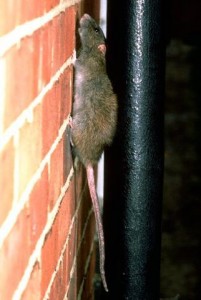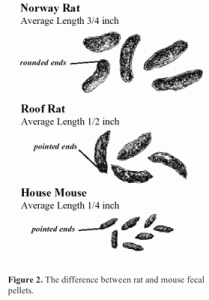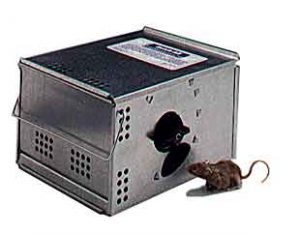 Almost everyone I know has had a mouse or two in their lifetime. For the most part you’ll get two different reactions to this ‘house guest’.
Almost everyone I know has had a mouse or two in their lifetime. For the most part you’ll get two different reactions to this ‘house guest’.
#1 “Oh he’s so cute-I hate to get rid of him” #2 “AAAAAAAAAAAAAAAAAWWWWWWWWWWEEKKKKKKKK!” I doubt this article will change your mind regardless of which category you’re in but at least you’ll have a better understanding on rodents and how to rid yourself of this vermin.
First some facts;
 than to be able to get into a smaller hole. (probably prehistoric New York city)
than to be able to get into a smaller hole. (probably prehistoric New York city)
Signs and symptoms of infestation
 Most of us don’t know we have a mouse living with us right away. It’s always a big surprise to walk into the kitchen late at night for a midnight snack and see a blur run across the floor. Mice produce just about 150 droppings (fecal matter) per day, so it’s not to long after a mouse moves in and gets to exploring HIS territory that you begin seeing his little presents. What’s even a worse thought is that mice urinate almost as much. If you want to see how much you’ll need a black light. Shining the light on surfaces like your counter tops, dish strainer, pots and pans, etc. will reveal a very disgusting reality. The reality that you need to get rid of that critter and quickly. Rats are a bit more secretive but no less disgusting. Rodents need three things that almost every home offers. Food, water and harborage. (mice do not need straight drinking water as rats do) Even the cleanest of homes can offer more than enough to sustain rodent but even if food and water are at a minimum, a place to call home for a rodent is just as important and could be all the reason for this furry friend to decide to move in.
Most of us don’t know we have a mouse living with us right away. It’s always a big surprise to walk into the kitchen late at night for a midnight snack and see a blur run across the floor. Mice produce just about 150 droppings (fecal matter) per day, so it’s not to long after a mouse moves in and gets to exploring HIS territory that you begin seeing his little presents. What’s even a worse thought is that mice urinate almost as much. If you want to see how much you’ll need a black light. Shining the light on surfaces like your counter tops, dish strainer, pots and pans, etc. will reveal a very disgusting reality. The reality that you need to get rid of that critter and quickly. Rats are a bit more secretive but no less disgusting. Rodents need three things that almost every home offers. Food, water and harborage. (mice do not need straight drinking water as rats do) Even the cleanest of homes can offer more than enough to sustain rodent but even if food and water are at a minimum, a place to call home for a rodent is just as important and could be all the reason for this furry friend to decide to move in.
What to do?
Well now that you have em, you have to get rid of them. How? If you don’t wish to kill the mice there are live traps that are quite effective. “Tin Cat” and “Ketch All” are two that work very well. They simply catch the mouse and it’s trapped until you take the trap to another location, open the lid and let the mouse go. Mind you these types of traps are not going to work on rats (rats are to big). You could ‘live trap’ rats with the same type of trap used to catch raccoons and the like but I’m not sure anyone would even want to. The other alternative is to exterminate the rodent. Since there is no way of knowing exactly how many mice or rats you’re dealing with this is probably the better choice.
“Tin Cat” and “Ketch All” are two that work very well. They simply catch the mouse and it’s trapped until you take the trap to another location, open the lid and let the mouse go. Mind you these types of traps are not going to work on rats (rats are to big). You could ‘live trap’ rats with the same type of trap used to catch raccoons and the like but I’m not sure anyone would even want to. The other alternative is to exterminate the rodent. Since there is no way of knowing exactly how many mice or rats you’re dealing with this is probably the better choice.
How to trap a rodent
 Glue Boards; Very inexpensive and effective method. Most rodent glue boards now come ‘pre-scented’ with an attractive odor.Place the glue board against the wall in a known area of rodent activity or directly at the edge of a hole where you know the little guy comes and goes. If possible try to set it where the mouse has to travel over the board. Such as the backside of the fridge or dresser where the wall and back comes close. You could even use a box or other object to make a ‘gauntlet’ leaving the rodent no choice but to walk over the glue and get stuck. If you have pets and there’s a chance of them getting stuck then place the board in a shoe box or pizza box with small holes cut into the edge where they can enter. Should a pet get stuck-use scissors coated with dish soap and gently cut the glue board away.
Glue Boards; Very inexpensive and effective method. Most rodent glue boards now come ‘pre-scented’ with an attractive odor.Place the glue board against the wall in a known area of rodent activity or directly at the edge of a hole where you know the little guy comes and goes. If possible try to set it where the mouse has to travel over the board. Such as the backside of the fridge or dresser where the wall and back comes close. You could even use a box or other object to make a ‘gauntlet’ leaving the rodent no choice but to walk over the glue and get stuck. If you have pets and there’s a chance of them getting stuck then place the board in a shoe box or pizza box with small holes cut into the edge where they can enter. Should a pet get stuck-use scissors coated with dish soap and gently cut the glue board away.
Snap traps are also great for catching vermin and also cheap and most of the same rules apply as for glue boards. One note; rodents can be highly suspicious and in some cases you may need to set the traps in place but not set to go off. After a day or so they’ll lose this shyness and you can set the trap then. Remember, mice and rats have poor vision but excellent reactions. If you place any trap in the middle of the room the chances are you won’t get your target, placing it along the wall will be an area the rodent will go anyway and lessens his area of movement so he has less chance of jumping out of the traps strike. (yes they can be that quick) A half caught rat can leave the area trap and all. To prevent this you can tie a string to the trap and something heavy. The rat will usually tire and die in short order. This string method is also great for trapping rats in places like your attic. This prevents him from wandering to an unaccessible area there decomposing and stinking up the place. Also, while peanubutter or cheese is the most classic type of attractant for such traps you might do much better with a cottonball with a drop of vanilla extract on it or even beef jerky. Anything that has a strong odor and can be semi secured to the trigger.
and lessens his area of movement so he has less chance of jumping out of the traps strike. (yes they can be that quick) A half caught rat can leave the area trap and all. To prevent this you can tie a string to the trap and something heavy. The rat will usually tire and die in short order. This string method is also great for trapping rats in places like your attic. This prevents him from wandering to an unaccessible area there decomposing and stinking up the place. Also, while peanubutter or cheese is the most classic type of attractant for such traps you might do much better with a cottonball with a drop of vanilla extract on it or even beef jerky. Anything that has a strong odor and can be semi secured to the trigger.
Baits. Highly effective and probably the easiest to do but also can come with the most risk. It’s to easy to just toss baits under a sink or behind a couch and then forget them.I don’t know how many times I’ve seen D-Con bait boxes just willy nilly around a home with kids and pets. This is irresponsible and the consequences could be immense . Baits should only be placed in areas inaccessible to kids and pets. Period! If the bait is to be placed in an area that doesn’t fit this criteria you need to put it in a tamper resistant station. These stations are lockable and the bait is secured inside to minimize any exposure. Most folks are against baits because they do not want the rodents dying in the walls and producing smells. Mice however do not produce much if any smell because they are so small. Rats however can stink while decomposing for a week or more.
As with any pest control procedure, know what you’re doing by reading the instructions on the product labels and use common sense to avoid unintended problems. Happy hunting!




